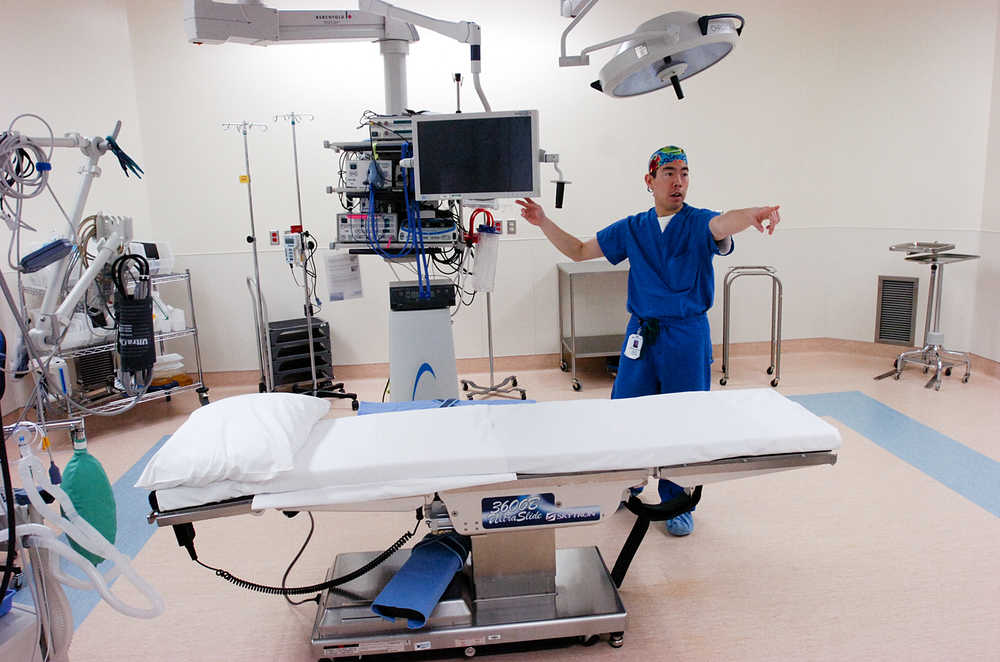Soldotna’s Central Peninsula Hospital, one of two borough funded hospitals on the Kenai Peninsula, has been expanding steadily since it began as a clinic operated by Dr. Paul Isaak in the late 1960’s. Since 1971, when it was an approximately 8,000-square-foot facility with 20 staff members, Central Peninsula Hospital has become a 228,973-square-foot facility with 773 on staff.
“This is kind of a demonstration of the economic driver that our hospital is for the community,” said Central Peninsula Hospital CEO Rick Davis in his quarterly financial report to the Kenai Peninsula Borough Assembly on January 20, 2015. “773 employees is a lot of payroll, a lot of housing, a lot of groceries and things like that.”
The Hospital’s most recent developments include the 2013 construction of a radiation oncology building, funded in part by a $2 million state grant, and the November 2014 purchase of a private urology clinic in Soldotna for $604,000. In February 2013 the borough approved the issue of $4.3 million in revenue bonds to fund the 87,981-square-foot addition of 5 clinics, including cancer clinics, a spine center, two foot clinics, and two gastrointestinal labs. The addition finished its permitting process and its bonds were issued in January 2014. Currently, the special clinics building is being built by Nesser Construction of Anchorage, and is expected to be completed in late January 2016.
“What that expansion’s going to do is give us a comprehensive spine center all in one place, which is really important – to have all those services in one continuous area,” said Davis. “And secondly, it completes our cancer center. When that building opens up, we’ll have a full cancer center with infusion and radiation oncology and medical oncology all under one roof.”
The hospital originally planned to install new MRI and CT machines in the speciality clinics building, giving it a total of three of each type of machine. In November 2013 the Alaska Department of Health and Social Services denied the hospital’s application for a required Certificate of Need for the design that included these two machines, but in January 2014 approved a design without them. Davis said that speciality clinic is being built with facilities to operate MRI and CT machines, and that one of the hospital’s currently existing MRI and CT machines may be moved into this space. Alternatively, Davis said the hospital could also reapply for state approval of new machines, but that they “hadn’t really started that process yet.”
“We were approved to shell those spaces in, and that’s what we’re doing right now,” Davis said. “And we haven’t really decided yet what we’re going to do as far as the equipment in them… Some of our options are to reapply with additional information, or to relocate existing equipment into that building, but we haven’t really decided which direction to go.”
In his speech to the assembly, Davis reported that at the end of 2014, Central Peninsula hospital had recorded a gross patient revenue of $131,443,000 – an increase of 13.4 percent from the revenue recorded at the same time in 2013. The hospital projected a continuing increase to $230,523,000 in 2015.
At the close of 2014, the hospital projected an opposite trend for its uncompensated care, which had by mid-2014 had risen by $7 million since 2009. However, projections from the end of 2014 predicted that it would decrease from the mid-2014 number of $20,438,000 to $18,237,000 by the end of fiscal year 2015 in June. Uncompensated care includes the categories of charity care, given to patients with an annual income less than 200% of the designation in the most recent Alaska Federal Poverty Guidelines, and bad debt incurred by those who’ve used the hospital’s loan program and are unable to make the monthly installments required. Although the hospital’s bad debt had increased by $800,000, its dollars spent in charity care had decreased by $2 million.
Davis said that the hospital’s charity care had come down 12% from July to December 2014.
“Not sure what that’s attributed to,” Davis said during the report. “It could possibly be more people having insurance because of the Affordable Care Act. People have signed up for that, and we’ve just had less charity care this year.”
In December 2014, the hospital transferred $4.3 million from its plant and replacement fund, a fund which Davis described as “money that the hospital uses, with the assembly’s approval, to replace our equipment and… facilities.” Davis said the transfer was to pay for bonds that contributed funding to the hospital’s growth, including those issued in the most recent bond sale to fund the hospital’s speciality clinic building.
Reach Ben Boettger at ben.boettger@peninsulaclarion.com

